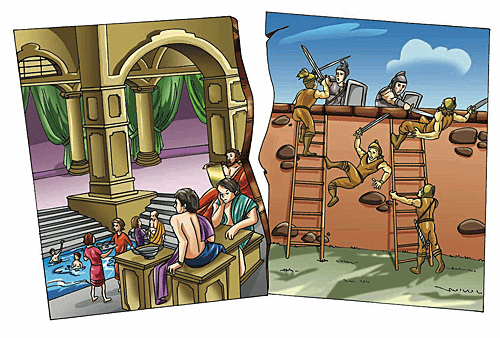English and Its Historical Development, Part 06
(Under Hadrian, the Romans built a wall to protect themselves from the Picts in Northern Britain)
Starting in A.D. 127, Hadrian's wall protected Southern Britain and the Romans from the attacks of the wild Northern Picts

The greatest surviving Roman landmark is a defensive wall begun in A.D. 122 after the Britains, in the words of Hadrian's biographer, "could no longer be held under Roman control".
The emperor Hadrian (117-138), inspected Britain personally and he determined to stabilize its northern frontier and reduce the drain on the military by constructing a fifteen-foot high wall across the entire seventy-three miles between Solway Firth and the mouth of the Tyne River. It took six years to build and stretched almost from sea to sea.
Hadrian's Wall
The empire must have limits, believed the emperor Hadrian, a notion that would have struck some previous rulers as heresy: Rome was meant to conquer the world.
To fulfill his more practical aim, Hadrian in A.D. 122 ordered his soldiers to build a wall across northern Britain that would, an early biographer wrote, "separate the Romans from the barbarians."
Winding over desolate moorland and along windswept crags, the 73-mile-long stone and turf barrier, originally as high as 15 feet, linked a chain of forts, guardhouses, and gates. To the north, in present-day Scotland, lived Celtic tribes, who on a few occasions overran the defenses.
Archaeologists have unearthed ample evidence of the frontier's lonely guardians. They have found game boards, letters written on thin sheets of sapwood, leather shoes and drinking cups, and a buried hoard of silver coins, perhaps a treaty offering to a local chief.
Magnificent though it now seems, its construction was greatly resented and there was hostility from the local populations on both sides of it. Turrets served as observation points sufficiently high to protect the sentries from attack.
The great barrier, the largest in the Roman Empire, included fortresses at every mile, 150 signal towers, and a fifteen-foot to thirty-foot ditch along its northern side. It was manned for its entire length by nearly 20,000 soldiers, who generally shielded the lands of southern England from the northern tribes.
Its purpose was not to repel large assaults, but to discourage small plundering expeditions and to serve as a base for attacks and counterattacks against hostile northern tribes.
In the third and fourth centuries, Roman punitive expeditions sometimes probed far north of Hadrian's Wall; at other times northern tribes crossed the wall and carried their devastation far to the south.
During most of the later age of Roman occupation, Hadrian's Wall marked the northern frontier of Roman Britain.
Proceed to Part 7, Celts break through Hadrian's wall.
INDEX or Table of Contents, English and its historical development.
References: sources of information.
